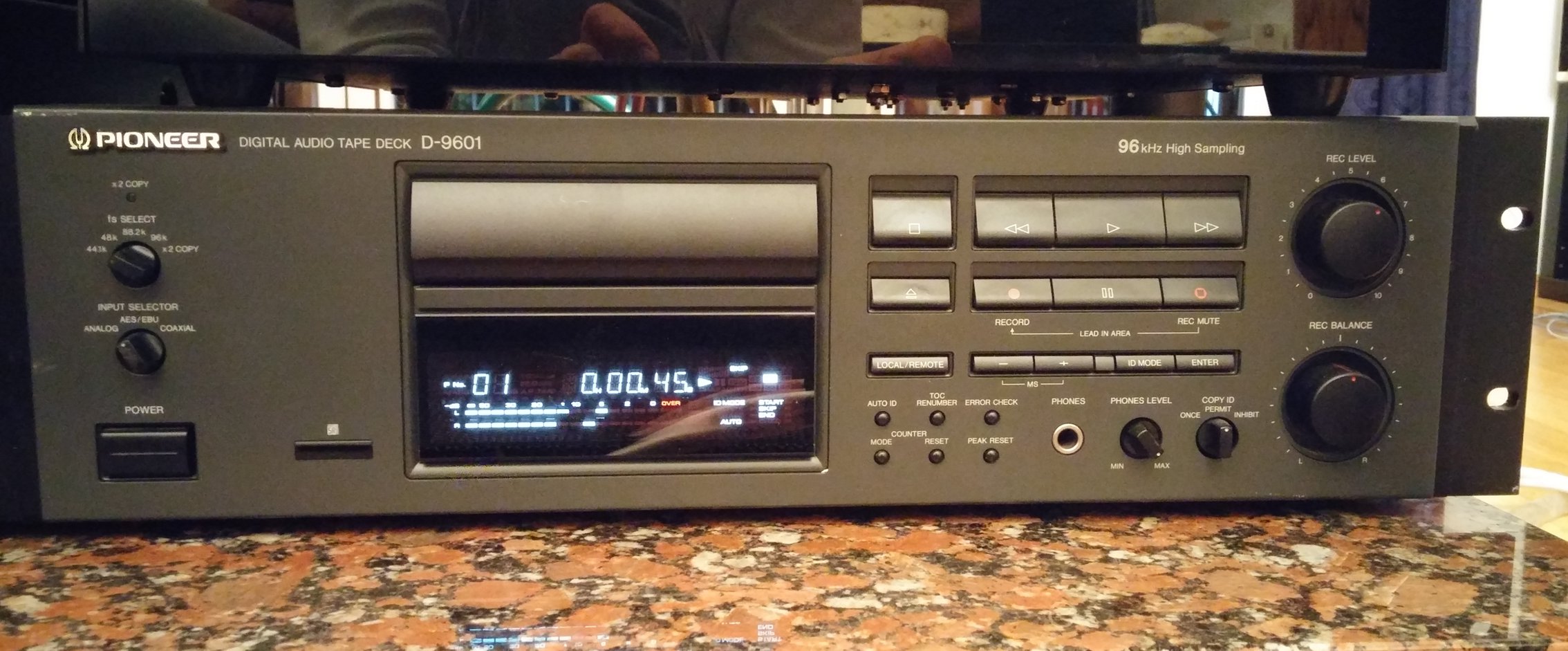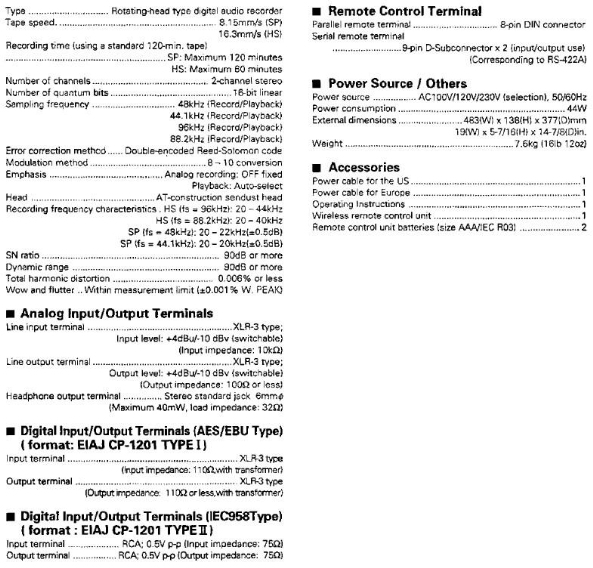Pioneer D-9601 DAT
D-9601 był profesjonalnym Hi-Sampling magnetofonem DAT Pioneera.
Oparty był na modelu konsumpcyjnym D-07.
D-9601 wyposażony XLR AES / EBU złącza wejścia / wyjścia, zmiany ID egzemplarza i RS-422.
D-9601 miał również coś, co rzadko realizowany, z wyjątkiem Casio (DA-1) oraz wiele jednostek Pioneer górnego zakończenia: TOC lub spisu treści. Ta sprytna funkcja pozwoliła napisać spis treści na początku taśmy, aby bez problemu odzyskać nagraną zawartość.
Tryb High Sampling (High Sampling)
To urządzenie jest wyposażone w tryb High Sampling (skrót: HS). Częstotliwość próbkowania może być wybrana jako 96 kHz lub 88,2 kHz. Dzięki obsłudze przetwarzania sygnałów LSI oraz silników wałka i bębna przy 2-krotnym trybie standardowym (SP) można wykonać nagrywanie i odtwarzanie powyżej 40 kHz. Ponieważ taśma ma działać z podwójną prędkością, czas nagrywania jest skrócony do połowy normalnego czasu; ale 1 godzina ciągłego nagrywania w trybie High Sampling jest możliwa z taśmą 120-minutową.
Wbudowany interfejs cyfrowy HS
Oprócz konwencjonalnego interfejsu cyfrowego, urządzenie jest wyposażone w cyfrowy interfejs HS, który umożliwia cyfrowe kopiowanie nawet w trybie HS. Cyfrowa edycja w trybie HS jest możliwa poprzez cyfrowe połączenie 2 lub więcej jednostek.
Tryb podwójnej szybkości kopiowania cyfrowego (x 2 kopie) Tryb
podwójnej prędkości (x 2 kopie) zapewnia cyfrowe połączenie dwóch lub więcej urządzeń, umożliwia cyfrowe kopiowanie z podwójną prędkością z taśmą w trybie standardowym (SP) ( częstotliwości próbkowania: 48 kHz i 44,1 kHz).
Dzięki tej funkcji czas potrzebny na cyfrowe kopiowanie jest zredukowany do połowy czasu konwencjonalnego, a ponieważ jest to kopia cyfrowa, nie ma pogorszenia jakości dźwięku.
Funkcja konwersji próbkowania
Przełączając przełącznik DIP na tylnym panelu, możliwe jest przesyłanie cyfrowych danych dźwiękowych z gniazda wyjściowego AES / EBU tego urządzenia w czasie trybu HS za pomocą filtru dziesiętnego w celu konwersji częstotliwości próbkowania na 96 kHz do 48 kHz (88,2 kHz do 44,1 kHz). Taśmy główne nagrane w trybie HS za pomocą tej funkcji umożliwiają łatwe cyfrowe kopiowanie na taśmę w trybie standardowym.
Ustawianie Auto ID Level
Podczas nagrywania w trybie Auto ID można zmienić poziom wykrywania ID początków między utworami. Można wybrać dowolne z następujących wartości: -40, -50, -60 i -70dB.
Wszechstronna funkcja
zdalnego sterowania Standardowym wyposażeniem jest RS-422, który jest standardem branżowym do edycji oraz 8-pinowy termi€ota zdalnego sterowania można nagrywać funkcje wyszukiwania, takie jak Up i Character Pack.
Funkcja danych subkodu
Ta funkcja zapisuje i usuwa wszystkie rodzaje informacji o czasie, w tym identyfikator początkowy, który wskazuje początek utworu, identyfikator pominięcia, który jest wygodny do pomijania fragmentów, których nie chcesz słuchać, oraz znacznik zakończenia, co oznacza dane liczbowe utworów i koniec nagrania. Ponadto, dane TOC, które są przydatne do edycji i katalogowania taśm, mogą być również rejestrowane, a korzystając z tych danych, można teraz przeprowadzić wyszukiwanie Al (Sztuczna inteligencja).
Funkcja Character Pack
Urządzenie jest wyposażone w funkcję nagrywania i odtwarzania (wyświetlania) danych znakowych zdefiniowanych w formacie DAT. Ta funkcja umożliwia analogowe nagrywanie tytułów utworów o długości do 60 znaków, nazw wykonawców, zapisów memo i innych danych znakowych na początku każdego utworu (jako zawartość początkowego ID), gdy dane postaci są odczytywane podczas odtwarzania, są one automatycznie przewijane (od prawej do lewej) w części wyświetlacza Licznik. Co więcej, ponieważ dane odczytu są przechowywane w mikrokomputerze, można je ponownie wyświetlić za pomocą prostego przycisku.
Uruchomienie funkcji pamięci
Status następujących ustawień przed wyłączeniem zasilania zostanie zapisany w pamięci nawet po wyłączeniu zasilania: Wybór lokalny / zdalny. Automatyczne wybieranie WŁ / WYŁ i poziom wykrywania pustej części między utworami.
Obwód dźwiękowy wysokiej jakości Dźwięk
wysokiej jakości był możliwy dzięki dostarczeniu 1-bitowego przetwornika D / A z przepływem impulsów, 1-bitowego liniowego przetwornika A / D o szerokim zakresie i czystego obwodu zegara, który tłumi kierunkowe wahania sygnału zegarowego Oś czasowa.



Pioneer D9601
High Sampling Rate DAT Recorder
Reviews : Stereo Recorder
PAUL WHITE ponders the benefits of a DAT recorder with a 40kHz audio bandwidth.
You could be forgiven for thinking that one DAT machine is very much like another, but Pioneer’s D9601 is not only a fully professional machine with balanced XLR analogue connections, both XLR AES/EBU and coaxial IEC958 digital I/Os and RS422 9-pin serial interface; it also has the ability to record at twice the standard sample rate, by running the tape and the internal electronics at double speed. DIP switches are provided on the rear panel to allow the user to customise various interfacing parameters and, like some others in the latest generation of DAT machines, the facility is provided to record up to 50 characters of text along with the start ID subcode data so that track titles, for example, can be displayed during playback.
Another benefit of this particular machine is that if you have access to two of them, there’s a double speed copy mode that lets you clone standard sample rate DATs from one machine to the other in half the usual time, and in a busy studio environment where you regularly need to backup DAT tapes, this could be a very valuable feature. The digital outputs can either pass on the high sample rate signal or down-convert to the standard rate, and a user-selectable copy ID system allows the user to specify whether the tape can be cloned freely, once only or not at all.
USING THE D9601
Because the operational and subcode editing aspects of this machine are similar to those of other professional DAT recorders, I’ll skip over the obvious stuff and get straight on with the listening tests. When working with a new tape, this should first be initialised to create a lead-in section around eight seconds long, which allows the machine to build a table of contents, much as you might find on a CD.
In operation, the D9601 behaves much as a conventional DAT recorder, and as with the Tascam DA20, alpha-numeric data is entered using the infra-red remote control included. Even at the standard sampling rate of 44.1kHz, the sound quality of this machine is impressive, no doubt due in part to the pulse-flow single bit D/A converter and the stable clock circuitry. If there’s a subjective difference when you switch to the 96kHz sample rate, it’s very subtle, especially on routine material. I thought I could detect a tiny difference in the openness of the stereo image, and the overall listening material seemed indefinably more comfortable, but this could simply be a case of the emperor’s new clothes: perhaps I heard a difference because I expected one.
IN SHORT…
You’ve really got to make up your mind why you need a high sample rate DAT recorder before going out of your way to buy one, and one of the best reasons for me is still the practical advantage of being able to make digital clones at twice normal play speed. For routine CD manufacture, I can’t see any advantage in recording at the higher rate, though I’ll be quite happy to listen to any reasons, either technological or philosophical, that anyone would care to raise.
The bottom line is that the D9601 is a reassuringly solid, friendly DAT machine with professional audio and digital interfacing as well as facilities for hardwire remote control and RS422 interfacing. As to the high sample rate capability, I feel that whatever benefits that might convey will not be fully realised until a high sample rate consumer format is released.
THAT INCREASED BANDWIDTH IN FULL…
The most interesting feature is obviously the ability to record at twice the usual sample rate, which equates to 88.2kHz or 96kHz as opposed to 44.1/48kHz. This pushes the audio bandwidth up to around 40kHz instead of the usual 20kHz, and though 20kHz is already above the upper hearing limit for most humans, it is generally accepted that if you cut out everything above 20kHz, there is a subjective difference in the way the sound is perceived.
This could simply be due to the way very high frequencies interact with each other to produce signals in the audible band, but other researchers claim that we perceive very high frequency signals in a way that can’t can’t be explained via conventional wisdom. In the case of digital systems, increasing the audio bandwidth helps avoid the side effects (often related to phase) of the very steep filtering, both analogue and digital, needed to produce a flat frequency response which approaches half the sampling frequency. Whatever the real reason, many of the people who use their ears for a living claim to be able to hear the difference.
At this point, you might reasonably ask why you need double sample rate recording, because ultimately, the results are likely to end up on CD with a standard 44.1kHz sampling rate anyway. If a standard CD is to be the ultimate destination for the recorded material, then I think it’s difficult to find a counter-argument to this. For high-quality vinyl recordings, however, and for material that may still be needed when the next generation of high sample rate CDs comes along, high sample rate recording is a good idea — though arguably only when working with analogue mixers and multitrack tape machines.
pros & cons
PIONEER D9601 £1695
PROS • Professional balanced audio interfacing plus AES/EBU and co-axial digital interfacing. • Good external controllability. • TOC and alpha-numeric facilities. • High sample rate option.
CONS • Using the high sample rates obviously halves the available recording time from a tape.
SUMMARY Pioneer build some really nice DAT machines and this one is no exception. This model has an excellent range of facilities, including the ability to record at both standard sample rates and double rate.

